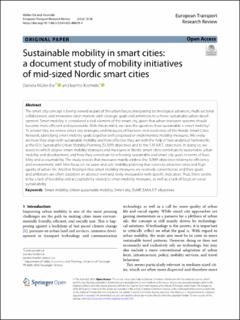| dc.contributor.author | Müller-Eie, Daniela | |
| dc.contributor.author | Kosmidis, Ioannis | |
| dc.date.accessioned | 2023-10-30T09:18:44Z | |
| dc.date.available | 2023-10-30T09:18:44Z | |
| dc.date.created | 2023-10-25T19:07:27Z | |
| dc.date.issued | 2023 | |
| dc.identifier.citation | Müller-Eie, D. & Kosmidis, I. (2023) Sustainable mobility in smart cities: a document study of mobility initiatives of mid-sized Nordic smart cities. European Transport Research Review, 15, 36 (2023) | en_US |
| dc.identifier.issn | 1867-0717 | |
| dc.identifier.uri | https://hdl.handle.net/11250/3099340 | |
| dc.description.abstract | The smart city concept is being viewed as part of the urban future, integrating technological advances, multi-sectorial collaboration, and innovative open markets with strategic goals and ambitions to achieve sustainable urban development. Smart mobility is considered a vital element of the smart city, given that urban transport systems should become more efficient and sustainable. With this in mind, we raise the question: how sustainable is smart mobility? To answer this, we review smart city strategies and measures of fourteen mid-sized cities of the Nordic Smart Cities Network, identifying smart mobility goals together with proposed or implemented mobility measures. We evaluate how they align with sustainable mobility and how effective they are with the help of two analytical frameworks: a) the EU’s Sustainable Urban Mobility Planning (SUMP) objectives and b) the S.M.A.R.T. objectives. In doing so, we assess to which degree smart mobility strategies and measures in Nordic smart cities contribute to sustainable urban mobility and development, and how they contribute to achieving sustainable and smart city goals in terms of feasibility and accountability. The study reveals that measures mainly address the SUMP objectives relating to efficiency and environment, with little focus on inclusive and safe mobility planning that caters to attractive cities and high quality of urban life. Another finding is that smart mobility measures are relatively conventional, and their goals and ambitions are often stated on an abstract level and rarely measurable with specific indicators. Thus, there seems to be a lack of feasibility and accountability related to smart mobility measures, as well as a lack of focus on social sustainability. | en_US |
| dc.language.iso | eng | en_US |
| dc.publisher | Springer Nature Switzerland AG | en_US |
| dc.rights | Navngivelse 4.0 Internasjonal | * |
| dc.rights.uri | http://creativecommons.org/licenses/by/4.0/deed.no | * |
| dc.subject | smart cities | en_US |
| dc.subject | smarte byer | en_US |
| dc.subject | mobilitet | en_US |
| dc.subject | transport | en_US |
| dc.subject | byplanlegging | en_US |
| dc.title | Sustainable mobility in smart cities: a document study of mobility initiatives of mid-sized Nordic smart cities | en_US |
| dc.type | Peer reviewed | en_US |
| dc.type | Journal article | en_US |
| dc.description.version | publishedVersion | en_US |
| dc.rights.holder | © The Author(s) 2023 | en_US |
| dc.subject.nsi | VDP::Samfunnsvitenskap: 200::Urbanisme og fysisk planlegging: 230::Urbanisme: 237 | en_US |
| dc.source.volume | 15 | en_US |
| dc.source.journal | European Transport Research Review | en_US |
| dc.identifier.doi | 10.1186/s12544-023-00610-4 | |
| dc.identifier.cristin | 2188565 | |
| dc.source.articlenumber | 36 (2023) | en_US |
| cristin.ispublished | true | |
| cristin.fulltext | original | |
| cristin.qualitycode | 1 | |

